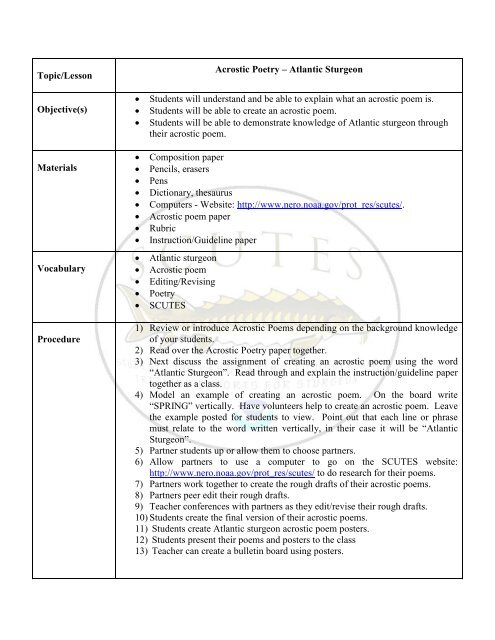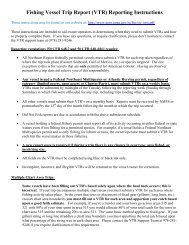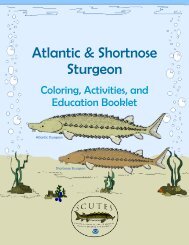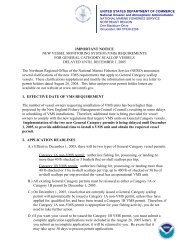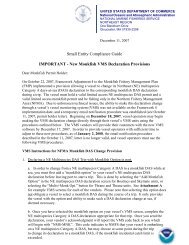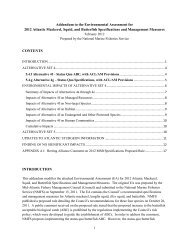Topic/Lesson Acrostic Poetry – Atlantic Sturgeon Objective(s ... - NOAA
Topic/Lesson Acrostic Poetry – Atlantic Sturgeon Objective(s ... - NOAA
Topic/Lesson Acrostic Poetry – Atlantic Sturgeon Objective(s ... - NOAA
Create successful ePaper yourself
Turn your PDF publications into a flip-book with our unique Google optimized e-Paper software.
<strong>Topic</strong>/<strong>Lesson</strong><br />
<strong>Objective</strong>(s)<br />
Materials<br />
Vocabulary<br />
Procedure<br />
<strong>Acrostic</strong> <strong>Poetry</strong> <strong>–</strong> <strong>Atlantic</strong> <strong>Sturgeon</strong><br />
• Students will understand and be able to explain what an acrostic poem is.<br />
• Students will be able to create an acrostic poem.<br />
• Students will be able to demonstrate knowledge of <strong>Atlantic</strong> sturgeon through<br />
their acrostic poem.<br />
• Composition paper<br />
• Pencils, erasers<br />
• Pens<br />
• Dictionary, thesaurus<br />
• Computers - Website: http://www.nero.noaa.gov/prot_res/scutes/.<br />
• <strong>Acrostic</strong> poem paper<br />
• Rubric<br />
• Instruction/Guideline paper<br />
• <strong>Atlantic</strong> sturgeon<br />
• <strong>Acrostic</strong> poem<br />
• Editing/Revising<br />
• <strong>Poetry</strong><br />
• SCUTES<br />
1) Review or introduce <strong>Acrostic</strong> Poems depending on the background knowledge<br />
of your students.<br />
2) Read over the <strong>Acrostic</strong> <strong>Poetry</strong> paper together.<br />
3) Next discuss the assignment of creating an acrostic poem using the word<br />
“<strong>Atlantic</strong> <strong>Sturgeon</strong>”. Read through and explain the instruction/guideline paper<br />
together as a class.<br />
4) Model an example of creating an acrostic poem. On the board write<br />
“SPRING” vertically. Have volunteers help to create an acrostic poem. Leave<br />
the example posted for students to view. Point out that each line or phrase<br />
must relate to the word written vertically, in their case it will be “<strong>Atlantic</strong><br />
<strong>Sturgeon</strong>”.<br />
5) Partner students up or allow them to choose partners.<br />
6) Allow partners to use a computer to go on the SCUTES website:<br />
http://www.nero.noaa.gov/prot_res/scutes/ to do research for their poems.<br />
7) Partners work together to create the rough drafts of their acrostic poems.<br />
8) Partners peer edit their rough drafts.<br />
9) Teacher conferences with partners as they edit/revise their rough drafts.<br />
10) Students create the final version of their acrostic poems.<br />
11) Students create <strong>Atlantic</strong> sturgeon acrostic poem posters.<br />
12) Students present their poems and posters to the class<br />
13) Teacher can create a bulletin board using posters.
Accommodations/<br />
Modifications<br />
• preferential seating<br />
• peer partnering/cooperative learning<br />
• multiple step instructions/guidelines/strategy<br />
• teacher check-ins<br />
• refocusing<br />
• rubric<br />
• step-by-step written instructions<br />
• scribing when necessary/alphasmarts
<strong>Acrostic</strong> Poems<br />
<strong>Acrostic</strong> poems are simple poems in which the first letter of each line forms a word or<br />
phrase (vertically). An acrostic poem can describe the subject or even tell a brief story<br />
about it. Your poem should be about the topic word and each line should begin with a<br />
letter from the word.<br />
• Formed by writing a word vertically down the page<br />
• One letter per line<br />
• All capital letters<br />
• Each line of poetry must begin with the letter on that line and must pertain to the<br />
word<br />
• May use one word or a phrase<br />
• Does not have to rhyme<br />
• Use adjectives and phrases that describe the word<br />
Here is an example of an acrostic poem using the word “flowers”.<br />
F anciful colors,<br />
L ovely colors,<br />
O verflowing<br />
W ith blossoms, green leaves, and long stems.<br />
E veryone appreciates how they brighten up a room.<br />
R eaching out to the world<br />
S aying hello!<br />
The word is written vertically. Every letter of the word is the beginning of the sentence or<br />
phrase on each line. The sentences do not have to rhyme, or even flow together like it was<br />
telling a story.
<strong>Atlantic</strong> <strong>Sturgeon</strong> <strong>Acrostic</strong> Poem Instructions<br />
You will work with a partner to create an acrostic poem for the words “<strong>Atlantic</strong> <strong>Sturgeon</strong>”. Your<br />
poem does not have to rhyme or tell a story. <strong>Atlantic</strong> sturgeon must be written vertically down<br />
your page. Each line must start with whichever letter it corresponds to from the words “<strong>Atlantic</strong><br />
sturgeon”. Each sentence or phrase that you write on each line must be accurate; meaning it<br />
must be a true fact about <strong>Atlantic</strong> sturgeon. You will use a specific website to research factual<br />
information about <strong>Atlantic</strong> sturgeon before you start writing the poem. Make sure you use good<br />
adjectives in your acrostic poem.<br />
1. First, write a rough draft. Play around with different creations.<br />
2. Next, you and your partner will peer edit the rough draft, making any necessary revisions.<br />
3. Make sure you conference with a teacher before you begin writing the final copy.<br />
4. You are going to create an <strong>Atlantic</strong> sturgeon acrostic poem poster. Using long white paper,<br />
you will write the final copy of the acrostic poem and create an illustration to correspond with<br />
your poem.
Followed Instructions<br />
Organization<br />
Accurate Facts<br />
Creativity<br />
Punctuation<br />
<strong>Atlantic</strong> <strong>Sturgeon</strong> <strong>Acrostic</strong> Poem Rubric<br />
Student followed assignment instructions<br />
accurately. Student created an acrostic<br />
poem using the words “<strong>Atlantic</strong> sturgeon”<br />
and followed the guidelines. Poem was<br />
completed on time.<br />
Student set up their acrostic poem currently.<br />
The words “<strong>Atlantic</strong> sturgeon” were written<br />
vertically, with a sentence or a phrase<br />
written after each letter.<br />
Student completed necessary research to<br />
complete their acrostic poem. All sentences<br />
and phrases contain accurate facts about<br />
<strong>Atlantic</strong> sturgeon.<br />
Student used creativity when writing their<br />
acrostic poems. Student used good<br />
adjectives and colorful language. Student<br />
used good word choice and unique<br />
vocabulary.<br />
Student fixed any spelling mistakes,<br />
punctuation, and grammatical/mechanical<br />
errors.<br />
_____ points<br />
Out of<br />
20 points<br />
_____ points<br />
Out of<br />
20 points<br />
_____ points<br />
Out of<br />
20 points<br />
_____ points<br />
Out of<br />
20 points<br />
_____ points<br />
Out of<br />
20 points
<strong>Acrostic</strong> Poem (Teacher Example)<br />
A nadromous fish,<br />
T racked down by scientists,<br />
L iving fossil,<br />
A tlantic Ocean is their home (some of the time).<br />
N atal homing helps them to find their way to their natal river to spawn.<br />
T hreatened proposed listing in the Gulf of Maine,<br />
I nteresting bottom feeders,<br />
C aviar is a human delicacy that comes from sturgeon.<br />
S cutes line in rows along their body.<br />
T ags are a way to keep track of them.<br />
U nderwater migrators,<br />
R ows of bony scales called scutes,<br />
G entle giants,<br />
E ndangered proposed listing for the entire range except for the Gulf of Maine,<br />
O verfishing was their downfall.<br />
N ew research and awareness will help bring the population up again.


